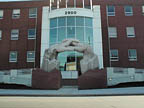

"This is the largest sculpture we have done," said White, who shares a studio with Lawler in Stephensport, KY. "It weighed over 100,000 pounds. It was wild and a little scary."
White explained that she and Lawler submitted the sketch in an open competition that was held by the NIA Center, which is a part of the Economic Opportunity Campus. "The center is to service the community as job training and starting new businesses," she said. "The fluted columns represent the center, and the hand coming from the rough rock represents the community. Together they form the 'Opportunity Portal.'"

Finding the block
Once the sculptors were notified in December of 1998 that they won the competition, they began calling quarries in Bedford and Bloomington, IN, looking for a 4 1/2- x 4 1/2- x 14-foot block. "We couldn't get any quarry to cut it," said White. "Finally, we got Reed Quarry. They really didn't want to do it, because it is hard on the equipment and to get out of the quarry."According to Ted Reed of Reed Quarry, the weight was a concern. "We weren't sure if [the machines] could handle it weight-wise," he said, adding that the block weighed over 20 tons -- twice the size of a typical block. "We usually put two of those on the truck. This block took up the whole truck."
Because of the weight of the block, Reed explained that slings had to be used instead of stone hooks and chains during the cutting process. In addition, a crane had to be used to lift the block because the company's forklifts can only handle up to 18 tons. "We had to get the truck pretty close to where the crane was," said Reed. "It was rather testy."
In the end, everything worked out. "We went to look at [the block], and we liked it," said White, adding that they had to get an overweight permit because the block was so large. Reed said that they decided to accept the challenging job because they have done work with White and Lawler before. "Meg is outstanding," he said. "She does great work. [But], I think they were even nervous about [this job]."
Indiana limestone was chosen for the sculpture because of its location and its consistency, said White. "Limestone is our primary material basically because it is so close, and because of its dependability -- especially for something this size," she said. "We knew that we were going to get a good quality across, and wouldn't have to worry about running into defects or a bad vein. It's a great working material."
In order to work on the 14-foot block, the sculptors bought a Geodesic Dome
-- a steel structure 38 feet in diameter, 16 feet high and equipped with a cover to protect the stone from weather conditions. "It took a day to set up," said White, adding that they worked under it from May until September.
"In September, we took the hands that weren't complete, and put them on top of the uprights and finished them that way," she said. White explained that each upright measures 8 feet. Because the stones for these two pieces were available before the large block, the sculptors began working on them first, to get things started.
According to the sculptor, the bulk of the work was on the hands themselves. "The worst part was carving up inside the palm," said White. "Dust and pieces of rock would get into your eyes." Among the equipment used to carve the hands were pneumatic tools such as angle grinders, chop saws and air hammers. "A lot of chisels were used for shaping and removing areas between the fingers," said White. An hydraulic chainsaw was also used. "That was real helpful for removing large chunks of stone -- up to two tons," said the sculptor. She explained that the chainsaw was used to make an 18-inch cut, and then it was split off with wedges.

Installing the hands
"On May 17 we had everything finished, and we were really happy," said White. "The trucks and cranes came in [to lift the hands.] We were worried about cracking, but everything went absolutely fine."According to White, the pieces were lifted onto the truck, and then she and Lawler had a day to look their work over and make final adjustments. They then drove 50 miles to the job site to assemble the sculpture.
A post-and-lentil construction method was used for the installation. There were sockets in the hands and tendons on each upright with a 1Ã 2-inch leeway. "It was great," said White. "It went up just perfect."
As a finishing touch, the hands were grounded by brickwork, which was installed by John Brach Construction in Louisville, KY. "We used Adobe Photoshop to play around and see what the brick would look like with the stone [before it was actually done]," said White. "[The brick] makes it look like these hands are breaking up through restrictions."
